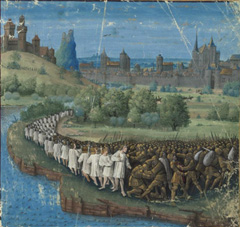Battle of Civetot 1096
Submitted by walwynThe Battle of Civetot took place on the 21st of November 1096 between the Seljuks, under Sultan Kilij Arslan I, and a ragtag undisciplined army known as the "People's Crusade". Using feigned retreats and archery, the Turks annihilated the crusaders. Most were killed or enslaved; and only a few, including Peter the Hermit (who was in Constantinople negotiating supplies), escaped.
The People’s Crusade, also called the Peasants’ Crusade or Poor People’s Crusade, was an uncoordinated, unofficial prelude to the First Crusade, that occurred in 1096. Launched in response to Pope Urban II’s call at the Council of Clermont (November 1095) for a crusade to liberate Jerusalem, it consisted largely of untrained, poorly equipped commoners, pilgrims, and minor knights, rather than the organized feudal armies Urban had envisioned.

Peter the Hermit, a charismatic French monk, was the most prominent leader. Described as a persuasive preacher, he led a large group from France and Germany, promising divine protection. Chroniclers like Albert of Aachen later exaggerated his role, but he was a central figure.1
To reach Constantinople, they had to pass through Hungary and the Byzantine Balkans. King Coloman of Hungary initially allowed passage, but the undisciplined bands of crusaders often looted and attacked locals.2
In response, Hungarian forces defended their territory and retaliated harshly. One of the more infamous incidents occurred when a band of crusaders (sometimes associated with Emicho of Leiningen’s group, which had already massacred Jews along the Rhine) entered Hungarian lands. Coloman’s army crushed them, killing many and stripping the survivors of arms and possessions before driving them out.3
Other groups, often disorganized, were led by figures like Count Emicho of Leiningen, whose followers in the Rhineland infamously massacred Jewish communities, viewing them as “enemies of Christ.”
Multiple groups, totaling perhaps 20,000–40,000 (estimates vary widely), set out from France, Germany, and the Low Countries. They included men, women, and children, with minimal military training or supplies. Many believed God would miraculously deliver them.
By summer 1096, survivors reached Constantinople. Emperor Alexios I, expecting disciplined armies, was dismayed by the ragged mobs. Unable to support them, he ferried them across the Bosporus to Asia Minor, urging them to await the main crusader forces.4
Encamped near Nicaea (a Seljuk stronghold), they ignored Byzantine advice and raided Turkish territory. The Seljuks, under Sultan Kilij Arslan I, ambushed them in a series of engagements culminating in the Battle of Civetot.
At dawn on the 21st of October the crusaders left their encampment and marched in a column with the knights on horseback, but without armour, towards Sultan Kilij Arslan I forces who were hidden in the hills. The Turkish archers took aim and within minutes most of the knights had been killed, followed by the foot soldiers. The rest of the crusader army fled back to their camp followed by Turks. A small number managed to barricade themselves into an abandoned fortress where they were later rescued by Byzantine boats. The young women and boys captured in the camp were either distributed amongst the Turkish commanders or sold as slaves.5
- 1.
The Crusades London Simon & Schuster 2012.p41.
- 2. The Crusaders stripped by the Hungarians. Miniature taken from the Overseas Passages of Sébastien Mamerot. Date circa 1474
- 3. The People’s Crusade https://crusadesandcrusaderscom.wordpress.com/2020/10/15/the-peoples-cru...
- 4.
The Crusades Through Arab Eyes London Saqi 1983.p5.
- 5.
The Crusades Through Arab Eyes London Saqi 1983.p8.
